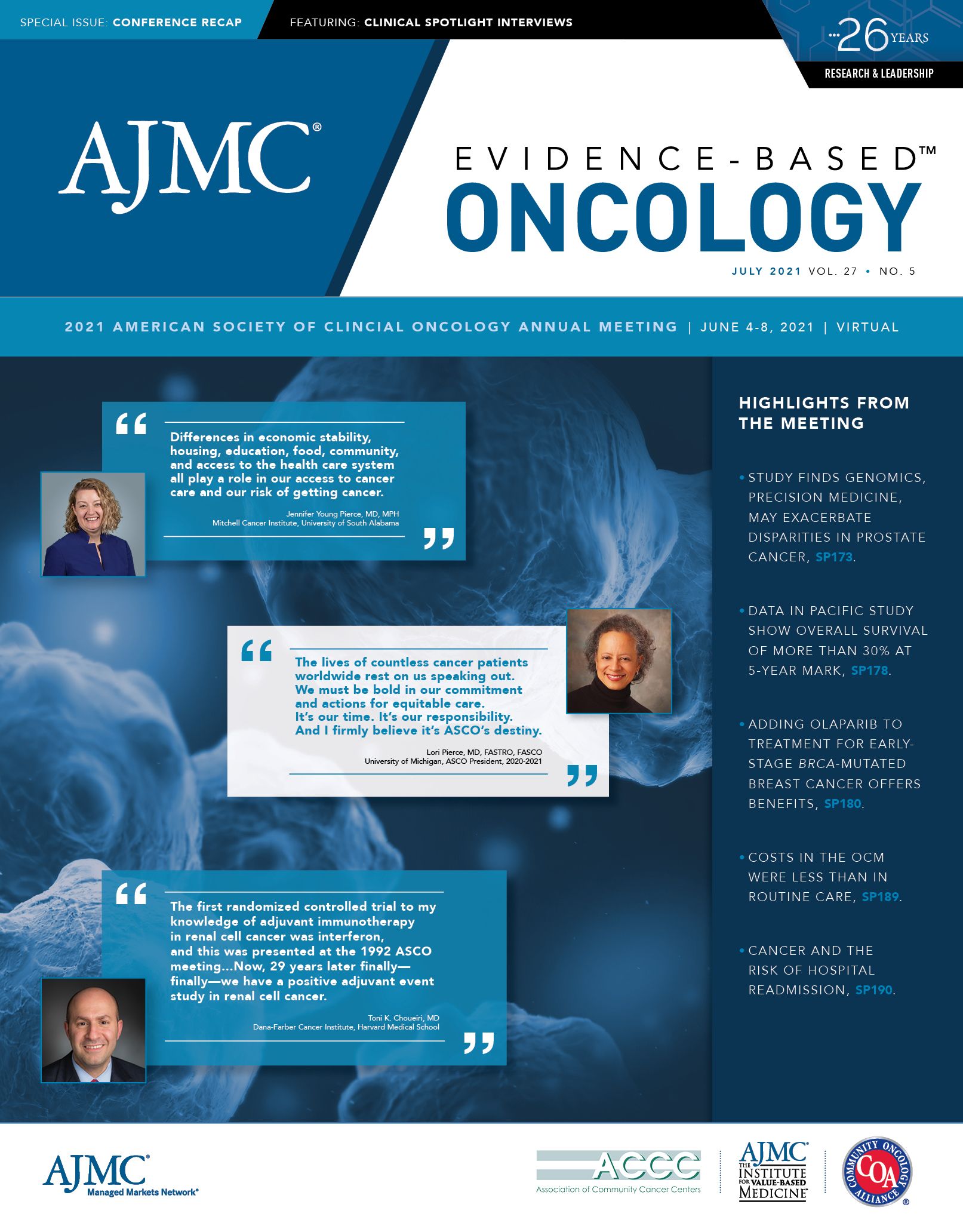Publication
Article
Evidence-Based Oncology
ASCO 2021 Recap: Targeted Therapies
Author(s):
Adding Olaparib to Treatment for Early-Stage BRCA-Mutated Breast Cancer Yields Benefits, Study Shows
Giving olaparib to patients with certain BRCA-mutated breast cancers for 1 year after they were treated with chemotherapy, surgery, or radiation significantly improved disease-free survival, according to results presented at the 2021 American Society of Clinical Oncology (ASCO) Annual Meeting.
Results from the OlympiA trial are important because they show that adding olaparib, a PARP inhibitor, also benefits patients with early-stage disease, in addition to the drug’s known benefits
in similar patients with metastatic disease. Patients in the study had BRCA 1/2 germline, or inherited, mutations and high-risk, early-stage cancer that was negative for HER2.
Results released June 3, 2021, were simultaneously published in the New England Journal of Medicine (NEJM).1 ASCO officials characterized the results as practice-changing and said the outcomes highlighted the need for genetic testing in patients who receive a diagnosis of high-risk breast cancer.
Inherited mutations cause between 5% and 10% of breast cancers, but these cancers can be more aggressive and deadly than many others. While the lifetime risk of breast cancer is about 12% for women overall, for women with BRCA mutations, it’s 72%. These women also tend to develop breast cancer at younger ages and in both breasts than those without the mutation.2
“OlympiA’s findings highlight the need for genetic testing for BRCA mutations in patients diagnosed with high-risk, early-stage breast cancer. These results could have an important impact on treatment decisions for this patient population, possibly including the use of a PARP inhibitor in the adjuvant setting,” ASCO president Lori J. Pierce, MD, said in a statement.3
The study randomized 1836 patients to receive olaparib or placebo. Results at a prespecified event-driven interim analysis were as follows:1
• The 3-year invasive disease–free survival was 85.9% in the olaparib group and 77.1% in the placebo group, for a difference of 8.8 percentage points (95% CI, 4.5-13.0). The HR for invasive disease or death was 0.58 (99.5% CI, 0.41-0.82; P < .001).
• The 3-year distant disease–free survival was 87.5% in the olaparib group and 80.4% in the placebo group, for a difference of 7.1 percentage points (95% CI, 3.0-11.1). The HR for distant disease or death was 0.57 (99.5% CI, 0.39-0.83; P < .001).
• The 3-year estimated overall survival was greater with olaparib but not statistically significant at the time of the interim analysis.
• Adverse events (AEs) were consistent with those in earlier studies with olaparib. Serious AEs did not occur more frequently with olaparib than with placebo.
“Olaparib had limited effects on global patient-reported quality of life,” the authors wrote in NEJM.
The results are the first to report the effects of a PARP inhibitor as an adjuvant therapy on survival end points. As such, lead author Andrew Tutt, MB ChB, PhD, of the Institute of Cancer Research, King’s College, said that they suggest a possible addition to the standard of care for patients with germline BRCA1/2 mutation–associated early breast cancer whose risk of cancer recurrence is higher. More follow-up is planned.
Olaparib is sold as Lynparza by AstraZeneca/Merck; AstraZeneca funded the study with the National Cancer Institute.
References
1. Tutt ANJ, Garber JE, Kaufman B, et al; OlympiA Clinical Trial Steering Committee and Investigators. Adjuvant olaparib for patients with BRCA1- or BRCA2-mutated breast cancer. N Engl J Med. Published online June 3, 2021. doi:10.1056/NEJMoa2105215
2. Large study verifies cancer risk for women carrying BRCA1 or BRCA2 mutations. News release. National Cancer Institute; July 12, 2017. Accessed June 8, 2021. https://www.cancer.gov/news-events/cancer-currents-blog/2017/brca-mutation-cancer-risk
3. PARP inhibitor significantly improved disease-free survival in patients with high-risk early-stage HER2-negative breast cancer with BRCA 1/2 mutations. News release. American Society of Clinical Oncology; June 3, 2021. Accessed June 8, 2021. https://www.asco.org/about-asco/press-center/news-releases/parp-inhibitor-significantly-improved-diseasefree-survival
Sotorasib, First Approved KRAS-Targeting Cancer Drug, Looks Promising
On the heels of FDA’s accelerated approval of sotorasib (Lumakras; Amgen), researchers
presented results from the phase 2 trial that led to drug’s approval at the virtual annual meeting
of the American Society of Clinical Oncology (ASCO) on June 4.1
“I believe that based on the results, sotorasib represents the new standard of care for patients
with KRAS G12C–mutated non–small cell lung cancer (NSCLC) that have failed at least
1 prior line of systemic therapy,” said lead investigator Ferdinandos Skoulidis, MD, PhD,
of the MD Anderson Cancer Center in Houston, in an interview.
Sotorasib, taken as a daily pill, targets mutated versions of the KRAS gene. Researchers have
long identified these mutations as instrumental in the development of cancer, but the gene has been an elusive target for treatment for decades. Skoulidis explained that the gene has a “smooth and featureless surface” that makes it difficult for treatment agents to latch onto, making it possibly “undruggable.”
About 1 in 8, or 13%, of patients with nonsquamous NSCLC have tumors with the KRAS G12C–mutated genes that sotorasib targets, according to Skoulidis. He said that each year, about 13,000 US patients will be eligible to take the drug based on its current indications.
Sotorasib has the history-making distinction of being the first FDA-approved drug to target the KRAS gene, but the drug’s clinical and commercial fate is not certain. A current phase 3 trial, CodeBreak200, is comparing sotorasib with the established cancer drug docetaxel. Skoulidis said that results from previous studies suggest that sotorasib is more effective but that such
comparisons must be interpreted with caution; they aren’t as valid as head-to-head comparisons.
Sotorasib may also face competition: Mirati Therapeutics reported positive results for adagrasib, its KRAS G12C inhibitor, at a European lung cancer meeting earlier this year.2 Also, second-generation
KRAS-targeted drugs that are at various stages of development could overshadow sotorasib, despite its first-out-of-the-gate status.
Cost issues could be another hurdle. Media reports suggest that Amgen plans to price the drug at $17,900 a month, a price that payers may balk at depending on how the drug stacks up against its alternatives.3
Amgen included many of the results of the phase 2 trial, called CodeBreak100, in its previous announcement of the FDA approval, so results presented at the ASCO meeting and published simultaneously in the New England Journal of Medicine were somewhat anticlimactic. The results showed that 46 of 124 patients (37%) included in the analysis had an objective response to sotorasib; the median duration of response was 11.1 months, median progression-free survival was 6.8 months, and median overall survival was 12.5 months. Most patients (69.8%) experienced
treatment-related adverse events; for 20.6%, they were serious.
According to Skoulidis, among the most important findings of the phase 2 trial may be response seen in patients with a co-occurring mutation in the STK11 gene and an unmutated KEAP1 gene.
“Sotorasib works only in patients with KRAS G12C–mutated NSCLC, but it appears, based on these data, that there is a signal that it might work better in KRAS G12C–mutated NSCLC that harbors a co-mutation in STK11, particularly when KEAP1…is wild type,” Skoulidis said.
If the finding is confirmed in larger trials, it might point to a subgroup of patients who particularly benefit from Amgen’s KRAS-targeted drug and perhaps to its use as a first-line drug, noted Skoulidis.
Only 2 of 126 patients in the phase 2 trial were Black. Skoulidis said both Amgen and the participating academic institutions are aiming to improve inclusion of underserved and underrepresented patient populations in the follow-up phase 3 trial. He also hopes that the approval of sotorasib will “galvanize and activate efforts to routinely obtain comprehensive genetic profiling of basically any patient with locally advanced or metastatic NSCLC.”
References
1. Skoulidis F, Li BT, Dy GK, et al. Sotorasib for lung cancers with KRAS p.G12C mutation. N Engl J Med. Published online June 4, 2021. doi:10.1056/NEJMoa2103695
2. Riely G, Ou SI, Rybkin I, et al. KRYSTAL-1: activity and preliminary pharmacodynamic (PD) analysis of adagrasib (MRTX849) in patients (pts) with advanced non-small-cell
lung cancer (NSCLC) harboring KRASG12C mutation. J Thorac Oncol. 2021;16(Suppl 4):S748-S802.
3. Beasley D. FDA approves Amgen drug for lung cancer with specific mutation. Reuters. May 28, 2021. Accessed June 9, 2021. https://www.reuters.com/business/healthcare-
pharmaceuticals/fda-approves-amgen-drug-lungcancer-with-specific-mutation-2021-05-28/
ASCO Clinical Spotlight: Antoine Italiano, MD, PhD, on Extended Follow-up Findings of Larotrectinib in Patients With TRK Fusion Cancer
ANTOINE ITALIANO, MD, PHD, head of the early-phase trials and sarcoma units at Institut Bergonié, Bordeaux, France, addresses findings of an extended follow-up of larotrectinib in patients with TRK fusion cancer that indicated prolonged progression-free survival in those undergoing treatment with the NTRK inhibitor.
Findings of an extended follow-up of larotrectinib in patients with tyrosine receptor kinase (TRK) fusion cancer indicate that this neurotrophic TRK (NTRK) inhibitor is more effective than any other treatment for this patient population, said Antoine Italiano, MD, PhD.
EVIDENCE-BASED ONCOLOGY™ (EBO): Can you speak on the goals of this study in assessing longer follow-up of larotrectinib use in patients with TRK fusion cancer?
ITALIANO: The main point we have investigated in this study is a specific end point called the growth modulation index [GMI]. This represents the ratio of progression-free survival [PFS] on an investigational treatment, larotrectinib, vs the PFS on a previous line of treatment the patient received.
This end point, GMI, is particularly useful in settings where it’s very challenging to perform a randomized study and therefore to have a control arm. This is the case, for instance, with NTRK fusion, which is very rare. GMI allows [us to] use the patient as [their] own control, and we consider a GMI ratio of more than 1.33 to indicate very promising activity.
In this study, we analyzed the GMI for all the patients [who] received [a] previous line of therapy, and then larotrectinib, based on the presence of NTRK fusion. [A total of] 122 patients were included in the analysis, and we observed the GMI to be more than 1.33 in about 74% of patients. [This] means, clearly, that the most efficient systemic treatment in this specific population is the NTRK inhibitor.
EBO: Can you speak on the significance of the observed rise in GMI for those undergoing larotrectinib, and what benefits may come through longer PFS?
ITALIANO: Since we don’t have [a] randomized study, this intrapatient comparison, in which the patient is used as their own control, clearly indicates that larotrectinib is actually more effective than conventional treatment the patient has [previously] received. For me, this clearly suggests that at least for patients with NTRK fusion, the best systemic treatment is the NTRK inhibitor, larotrectinib.
We saw the ratio of more than 1.33 in about 74% of the patients, [well over half]. And more importantly, for a significant proportion of patients, the GMI was higher than 5; actually, the median GMI was 8.9. So, this clearly indicates that larotrectinib is more effective than any other treatment,
using this specific population characterized by NTRK infusion.
EBO: The GMI of several patients fell below the 1.33 threshold. Were any notable trends observed in these patient populations, or in those who met the threshold?
ITALIANO: [Yes], some patients [had a] GMI less than 1.33, but you have also to consider that a significant number of these patients we re censored, and so were not progressive at the time of statistical analysis. Importantly, for a majority of these patients, treatment was still ongoing,
so probably we will do a new update of this analysis in the next few months or few years. Probably, this proportion of patients with a GMI of less than 1.33 will decrease.
We did some subgroup analyses—for instance, [using] the age of the patient (pediatric vs adults); or the number of metastatic sites, so metastatic disease vs locally advanced disease; and in all these subgroups we observed in the majority of patients a GMI significantly higher than 1.33. So, the benefit of larotrectinib is evident in all the subgroups, and no specific subgroup benefits more than another.
Reference
Hong DS, Italiano A, Briggs A, et al. Intra-patient comparison from larotrectinib clinical trials in TRK fusion cancer: an expanded dataset. J Clin Oncol. 2021;39(Suppl 15)abstr 3114. doi:10.1200/JCO.2021.39.15_suppl.3114





